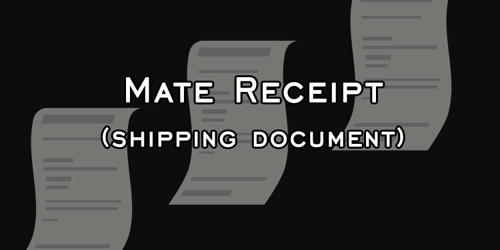Mate’s receipt is a document originally issued by the first mate of the ship. He was the officer responsible for cargo. It is a document given by the mate (master) of a ship acknowledging that the goods have been received on board. It is a temporary receipt issued and signed by the officer of a vessel, to acknowledge the goods ready to be loaded on a ship. It is a document issued by the carrier to the shipper, indicating receipt of the goods, but not loading on board.
Mate’s receipt is a receipt issued by the Commanding Officer of the ship when the cargo is loaded on the ship. It is a prima facie evidence that goods are loaded in the vessel. This acts as evidence that goods were loaded in the vessel but it does not have the same validity as for instance, the bill of lading. The shipper or his representative would then take the mate’s receipt to the master or the agent to exchange it for a bill of lading, which would incorporate any conditions inserted into the mate’s receipt.
Mate’s receipt is not a document of title of goods. It is merely a receipt of goods. However, it is an important document as, without it, the exporter will not be able to obtain the title document of goods, i.e., the bill of lading. This is a document used in the shipment of cargo. When the goods are received by or for the sea carrier, a “mate’s receipt” is issued either directly by the ship or by the ship’s agents. Originally the mate’s receipt was signed by the first mate of the ship, hence its name. Now, it can just as likely be signed by the ship’s agents.
Types of Mate’s Receipts:
(a) Clean Mate’s Receipt: The Commanding Officer of the ship issues a clean mates receipt if he is satisfied that goods are packed properly and there is no defect in the packing of the cargo or package.
(b) Qualified Mate’s Receipt: A qualified mate’s receipt is issued when the Commanding Officer of the ship is not satisfied with the packing of the goods and the shipping company does not take any responsibility for damage in transit.
Contents of Mate’s Receipt:
- Name and logo of the shipping line.
- Name and address of the shipper.
- Name and the number of vessels.
- Name of the port of loading.
- Name of the port of discharge and place of delivery.
- Packing and container description.
- Description of goods in terms of quantity.
- Gross weight in kg. and volume in terms of cubic meters.
- Shipping bill number and date.
- Signature and initials of the Chief Officer.
Significance of Mate’s Receipt:
- It is an acknowledgment of goods received for export on board the ship.
- It is a transferable document. It must be handed over to the shipping company in order to get the bill of lading.
- Bill of lading, which is the title of goods, is prepared on the basis of the mate’s receipt.
















